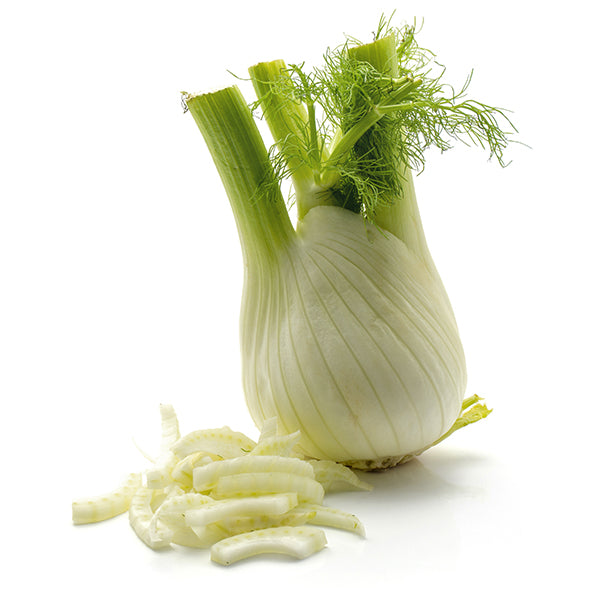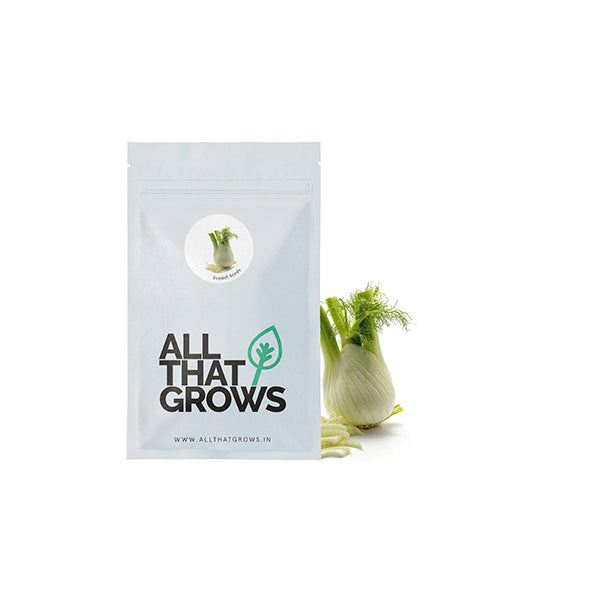



- SOWING
TIMESeptember and October
- Sowing
DistancePlant 10 -15 inches apart
- Fruit
WeightNA
- Fruit
ShapeHerb with feathery leaves on a bulb like base
- Days to
maturity90 - 100 days
- Details
- How to sow
- Reviews
Fennel, scientifically known as Foeniculum vulgare, is one of the most versatile garden plants that can be used as a vegetable, herb, and spice. Originating from the Mediterranean, it is a common plant found in Greek, European and Indian cuisine. A fennel plant may grow up to 3 to 5 ft in length with 4 to 10 cm long leaves and 30 to 40 tiny yellow flowers at the top. The base of the fennel has a crisp texture and the leaves are extensively used as a herb for flavoring in Indian recipes, both savory and sweet. Fennel is highly sought for its mildly sweet licorice-like flavor and it's health benefits which include better bone health, lowering high blood pressure, preventing heart diseases, boosting the immune system and improving metabolism. Fennel contains phosphorus, zinc, copper, iron, manganese, potassium, beta-carotene, lutein, and zeaxanthin, vitamin A, vitamin C, vitamin B6, vitamin E, and vitamin K. The customary tradition of chewing fennel seeds after meals to freshen breath and improve digestion is a common sight in Indian restaurants.
Planting instructions
Fennel seeds can be started indoors or planted directly outdoors.
To germinate fennel successfully, prepare a nutrient rich seedbed with well-drained soil since too fertilized soil may reduce the aromatic flavour of the plant.
Seed should be sown at a depth of 1 to 1.5 inches leaving 10 to 15 inches distance between plants and 24 inches distance between rows.
The soil temperature of 16 to 32°C is ideal for the growth of fennel plant.
Growing Requirements
watering
After sowing, water everyday until the shoots appear. Once shoots are visible, water twice weekly in moist soil and more frequently in dry soil.
pests
Two most common pests that attack fennel are aphids and armyworms. Both of these pests have common natural predators like the ladybug and dragonfly.
soil
The most important thing to ensure while preparing the soil for fennel is that the soil is well drained soil. If you’re planting in a pot, it is much more easier to control the properties of soil. Hence, choose an area of your garden/home that drains well.
temperature
Fennel grows well in cool temperature in the range of 16 to 32°C.
how to harvest
Fennel stalks should be cut just before flowering.
Seed heads should be collected promptly before they shatter.
The seed heads are ready to harvest when they turn brown in color. Once the stalks have been harvested, the bulb can also be cleaned and stored.

The productiveness of any seed we sell is subject to your local climatic conditions*, the sowing method you adopt, and your commitment to the planting process. We give no warranty, expressed or implied, and are in no way responsible for the produce.
Please note that all our seasonal recommendations/ sowing information is as per the local climatic conditions. *For more information on the optimum conditions required for growing seeds in your region, please contact us at, hello@allthatgrows.in or Whatsapp us at, +91 8544865077
Questions & Answers
Have a Question?
Be the first to ask a question about this.




Fennel Seeds
Seed Type : Non-Hybrid, Open Pollinated and Non-GMO
Leaf Color : Green leaves with yellow flowers
Fruit shape : Herb with feathery leaves on a bulb like base
Fruit Weight : NA
Maturity : 50 to 60 days
Head Type : Feathery leaves with tiny yellow color
Fennel, scientifically known as Foeniculum vulgare, is one of the most versatile garden plants that can be used as a vegetable, herb, and spice. Originating from the Mediterranean, it is a common plant found in Greek, European and Indian cuisine. A fennel plant may grow up to 3 to 5 ft in length with 4 to 10 cm long leaves and 30 to 40 tiny yellow flowers at the top. The base of the fennel has a crisp texture and the leaves are extensively used as a herb for flavoring in Indian recipes, both savory and sweet. Fennel is highly sought for its mildly sweet licorice-like flavor and it's health benefits which include better bone health, lowering high blood pressure, preventing heart diseases, boosting the immune system and improving metabolism. Fennel contains phosphorus, zinc, copper, iron, manganese, potassium, beta-carotene, lutein, and zeaxanthin, vitamin A, vitamin C, vitamin B6, vitamin E, and vitamin K. The customary tradition of chewing fennel seeds after meals to freshen breath and improve digestion is a common sight in Indian restaurants.
Seed Type : Non-Hybrid, Open Pollinated and Non-GMO
Leaf Color : Green leaves with yellow flowers
Fruit shape : Herb with feathery leaves on a bulb like base
Fruit Weight : NA
Maturity : 50 to 60 days
Head Type : Feathery leaves with tiny yellow color
- SOWING
TIMESeptember and October
- Sowing
DistancePlant 10 -15 inches apart
- Fruit
WeightNA
- Fruit
ShapeHerb with feathery leaves on a bulb like base
- Days to
maturity90 - 100 days
Planting instructions
Fennel seeds can be started indoors or planted directly outdoors.
To germinate fennel successfully, prepare a nutrient rich seedbed with well-drained soil since too fertilized soil may reduce the aromatic flavour of the plant.
Seed should be sown at a depth of 1 to 1.5 inches leaving 10 to 15 inches distance between plants and 24 inches distance between rows.
The soil temperature of 16 to 32°C is ideal for the growth of fennel plant.
Growing Requirements
watering
After sowing, water everyday until the shoots appear. Once shoots are visible, water twice weekly in moist soil and more frequently in dry soil.
pests
Two most common pests that attack fennel are aphids and armyworms. Both of these pests have common natural predators like the ladybug and dragonfly.
soil
The most important thing to ensure while preparing the soil for fennel is that the soil is well drained soil. If you’re planting in a pot, it is much more easier to control the properties of soil. Hence, choose an area of your garden/home that drains well.
temperature
Fennel grows well in cool temperature in the range of 16 to 32°C.
how to harvest
Fennel stalks should be cut just before flowering.
Seed heads should be collected promptly before they shatter.
The seed heads are ready to harvest when they turn brown in color. Once the stalks have been harvested, the bulb can also be cleaned and stored.



 Sign In
Sign In








